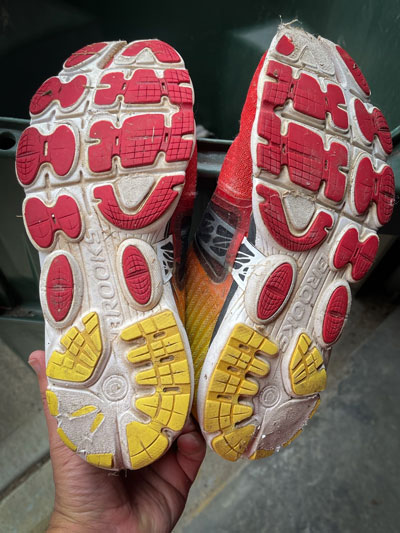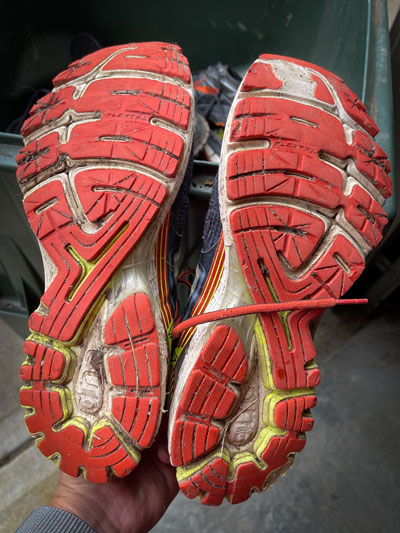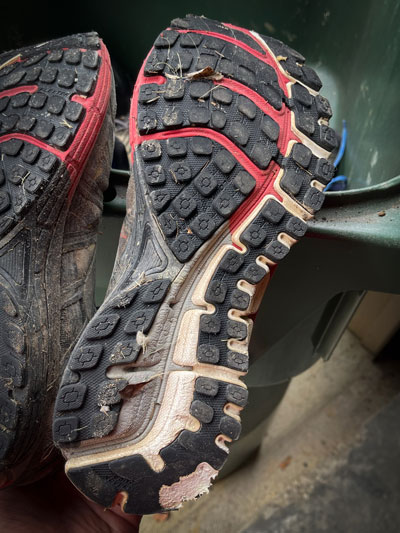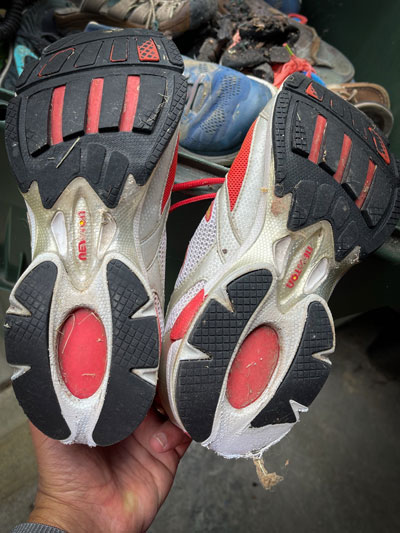Running Short: Running shoe mileage (part 2)

I have been running for a little while now, which means I have been logging my miles in a log and tracking the mileage for the running shoes I am using. Hopefully, you are too. Earlier I posted about logging the miles and when to replace the running shoes.

I usually have about 3 to 4 running shoes in rotation, with an additional one that I use for nonrunning activities. Yes, that last pair of running shoes I do not use for running but for doing other stuff or activities. This means I try to squeeze as much time and distance from the shoes as possible. Some shoes can cost a fortune.
I have a pair to use mostly for long-distance training runs and/or races. Another pair for shorter and track training runs, given the cushioning for those, might not be as effective for the longer runs. Also, in the rotation, a couple of trail shoes for single-track trails and other non-pavement types of terrain.

I will move a new shoe in rotation which I normally will use for long-distance runs, move the one I used to use for long-distance to shorter distances and lastly, move the last one to the yard purpose work. Yes, someone has to mow the lawn. That will officially retire the yard work to either donation or trash. That depends on the condition of the shoe.

Regarding the mileage, I will say that, on average, I have been able to get around 350 to 400 miles out of my running shoes. Some perform pretty well with over 600 miles, and some brands do not so well for me with barely 300. To me, there are two aspects,
1) The thread or traction I get. That will be obvious from the pictures below. If I feel that when on push off I am constantly losing traction or I am slipping when landing at the trails, for me, those are excellent indications to start considering replacing.
And 2) The cushioning I can still get out of the shoe even during the shorter miles. For the springiness of the shoe, I start thinking about how much of the rocks, debris, or edges of the surface I am feeling, especially during the first few miles of the run.
My decision to replace a shoe in the rotation will depend mostly on those two conditions unless there are catastrophic breaks of the shoe that will prevent me from using them for running.
Now, most of the time, I do not donate or toss them right away. I store them in the garage, and once in a while, I tackle the pile of shoes. That is what happened just recently, and I was surprised when I took notice of the number of pars and their condition.



It was a little bit sad to get rid of some of the running shoes, given that I still remember when I was trying or using some of them. For example, the Newtons, I remember from the Little Rock Marathon; when flying home, I talked to another runner about how much they loved them. I also remember when I tried them because that pair made me use my calves while forcing me to land on the ball of my foot. A lot of calf soreness every time I was using the Newtons.
The New Balance running shoes I started running many years back, for some reason still in the pile and had survived multiple pile purges. Those New Balance were the 1st pair I bought exclusively for running many years ago. Or the Rock and Roll Adrenaline Brooks with their distinctive guitars, in my favorite style, which is the Adrenaline, and a very decent price at the time. Also, the Hokas Clifton and Ricon from earlier this year, and how can I forget the Saucony Hurricane. Super comfortable, but they did not last too many miles losing the thread too quickly.
So, in a nutshell,
- Find the shoes that best fit your feet, running style, terrain, and training plan.
- Log the miles of your running pair and take also note about how they feel at the start and during the runs.
- For those preferred shoes, keep an eye for sales even if you do not need them at the time. Buy one or two extra pairs at a good price.
- Create a rotation plan for your running shoes to make the best and squeeze as many miles as possible.






















